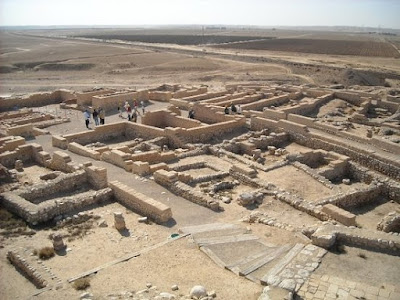עירד
Genesis 4:18 names him as a son of Chanoch (Enoch - חנוך), the grandson of Kayin (Cain), and notes that he fathered Mechuya-El (מחויאל), who in turn fathered Metu-Shalach, known in English as Methuselah (מתושלח).
The root of Iyrad is Arad (ערד), which is the Arabic equivalent of the Egyptian Hagar = "to flee". In the Assyrian, Ethiopian and Chaldean languages, Arad is the wild ass who the Edomites of Mount Se'ir called Chamor, the father of Shechem. He was worshipped by the Egyptians as Set, and to the Beney Yisra-El was Shet (Seth - שת), the third son of Adam and Chavah (Eve). Sha'ul the Benjamite who became the first king of Yisra-El was a Set-worshipper - not surprisingly either, for Sha'ul (שאול) is properly She'ol (שאול), the underworld, and Set was associated with the underworld through the slaying of Osher (Osiris).
Daniel 5:21 and Job 39:5 both use Arod (ערוד) to mean the "wild ass"; in Dani-El's case in Aramaic (עֲרָדַיָּא ). This links with Arodi - but click the link rather than me repeating all the data here.
The root-meaning - "to flee" - also connects Arad with Ard, and this despite the fact that Ard (ארד) is written with a first-letter Aleph (א) and not the Ayin (ע) of Arad - as both are phonetic renditions of a non-Yehudit word, this is not problematic; the same is true of Ardon (אַרְדּֽוֹן), which appears in 1 Chronicles 2:18 as the word for a "fugitive", and again with a first-letter Aleph.
Given that Irad means "to flee", can we presume that the shrine at Arad was a fugitive-shrine, which is to say one of the Beney Yisra-El refuge cities given to the Levites as their inheritance? There is a logic to this, though there is no reference to it as being such in the Tanach. What stirs the thought however is the tale of Hagar, who "fled", and quite literally, to precisely this region of the desert, and whose flight - Hagar/Hijrah/Hejira - then grows into the "flight" of Muhammad from Mecca, with Hagar once again the fleeing woman at the source of the founding of the shrine. There is clearly something very ancient, and very pan-Arabic, going on here, which neither the Tanach nor the Qur'an fully reflect, and which is repeated in the Phoenician, through Arvad (or possibly Arwad and even Ru'ad - אַרְוַד), likewise a refuge-city (cf Ezekiel 27:8).
Numbers 21:1 and 33:40, Joshua 12:14 and 1 Chronicles 8:15 all mention a town or shrine of that name in southern Kena'an, which is not the Arad that Israeli Tourism is desperate to take you to, between the Negev and the Judaean deserts - that is actually a modern city, founded as recently as 1962. But the original Arad, which is now the archaeological site of Tel Arad, is only five miles away - though the evidence is that this Arad was destroyed more than a thousand years before any Yisra-Eli had set foot there, and there is no evidence that they ever set foot there afterwards either.
The name appears (allowing for some scholarly dispute on the matter) in the Chronicles of Shoshenq I, named in the Bible as either Shishak (שִׁישַׁק) or Shoshak (שושק) - see, for example, 1 Kings 14:25, where the Masoretic edition gives one in the text and the other in parenthesis - who established the 22nd dynasty that ruled Egypt in the 10th century, at the time of the civil war in Yisra-El following the death of Shelomoh (Solomon). An inscription on the walls of one of the temples in Carnac includes Yeru-Shala'im among the cities that he sacked during his campaigns around the Middle East, and the map on the page linked here will show you the details of that inscription, as well as a map of his conquests, which included Arad.
Numbers 21:1 and 33:40, Joshua 12:14 and 1 Chronicles 8:15 all mention a town or shrine of that name in southern Kena'an, which is not the Arad that Israeli Tourism is desperate to take you to, between the Negev and the Judaean deserts - that is actually a modern city, founded as recently as 1962. But the original Arad, which is now the archaeological site of Tel Arad, is only five miles away - though the evidence is that this Arad was destroyed more than a thousand years before any Yisra-Eli had set foot there, and there is no evidence that they ever set foot there afterwards either.
The name appears (allowing for some scholarly dispute on the matter) in the Chronicles of Shoshenq I, named in the Bible as either Shishak (שִׁישַׁק) or Shoshak (שושק) - see, for example, 1 Kings 14:25, where the Masoretic edition gives one in the text and the other in parenthesis - who established the 22nd dynasty that ruled Egypt in the 10th century, at the time of the civil war in Yisra-El following the death of Shelomoh (Solomon). An inscription on the walls of one of the temples in Carnac includes Yeru-Shala'im among the cities that he sacked during his campaigns around the Middle East, and the map on the page linked here will show you the details of that inscription, as well as a map of his conquests, which included Arad.
Copyright © 2019 David Prashker
All rights reserved


No comments:
Post a Comment